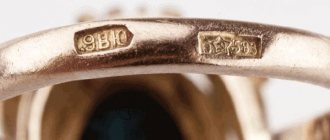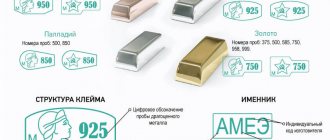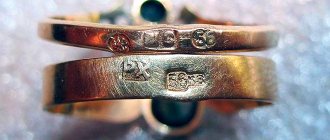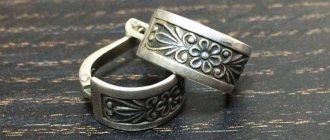Post updated: Oct 9, 2020
Very rarely gold is used in its pure form. Usually the product we call gold consists of the precious metal itself and the so-called alloy, that is, an admixture of other metals. Additives are included in the composition of gold to improve endurance and density, because gold in its pure form is very soft. Pure metal wears out quickly, and products made from it are very easy to scratch or break. High-quality products have a mark on the gold, which we will discuss later.
Even in ancient times, it was calculated that the best impurities for gold were silver and copper. Well, samples began to be used to indicate the gold content in the alloy.
Sample is the main indicator of impurities in a product, but stamps also serve this purpose - marks that are placed in control institutions and guarantee the presence of precious metal in the alloy.
In France, the first hallmark was placed in 1275, but in Russia, the first hallmark appeared on a product in Moscow in 1651-1652. It looked like a double-headed eagle with a date written in Slavic letters, and its purpose was to demonstrate the silver standard. Assays in the modern sense were introduced by Peter the Great in his decree of February 13, 1700, which established 4 assays each for gold and silver.
What is jewelry marking
Marking involves applying two-dimensional DataMatrix codes to gold, palladium and platinum products, which are read by a scanner and contain complete information about the product and about each stage within the cycle of transition from manufacturer to retail owner.
The introduction of labeling is intended to protect buyers from falsification and fraud. The state is striving to get rid of the shadow market and unscrupulous entrepreneurship - both in the field of selling synthetic counterfeits and smuggling, and in terms of inflating the cost of sold jewelry. Labeling also allows full access to information and thereby simplifies the work of supervisory authorities.
Labeling deadlines
Mandatory labeling in the jewelry industry was supposed to start at the beginning of 2021, but market participants were not ready for the new requirements, and the deadline had to be postponed.
The new deadlines are determined by Decree of the Government of the Russian Federation of February 26, 2021 No. 270.
| March 1, 2022 | From this day on, products (materials and decorations) produced or imported into the Russian Federation must have labels with Data Matrix codes, and participants in trade turnover must register the following information in the DMDK:
Barcodes for precious metals bars can be applied to passports and certificates. |
| March 1, 2023 | Each product item must have a marking code. Without a nanotag, you cannot produce or import “jewelry” from abroad, but for now you can store the remainder in a warehouse. |
| March 1, 2024 | Physical nanotags must be applied to all residues by this date. From March 1, 2024, stores will not be able to sell jewelry without a marking code. |
Decoding of the name
1 - year code 2 - code of the State Inspectorate of Assay Supervision, in the area of operation of which the manufacturer is located 3 - manufacturer code
breakdown by year: A - 2001, B - 2002, C - 2003, D - 2004, D - 2005, E - 2006, C - 2007, I - 2008
- the second indicates the inspection of the assay office: L - North-Western (no change)
| Assay inspections | Location | Codes on stamps |
| 1. Verkhne-Volzhskaya | r/p Krasnoe-on-Volge, Kostroma region. | IN |
| 2. Volgo-Vyatka | Nizhny Novgorod | G |
| 3. East Siberian | Krasnoyarsk | I |
| 4. Far Eastern | Khabarovsk | YU |
| 5. Donskaya | Rostov-on-Don | TO |
| 6. Western | village Yantarny, Kalaningrad region. | F |
| 7. Transbaikal | Ulan-Ude | AND |
| 8. West Siberian | Novosibirsk city | N |
| 9. Povolzhskaya | Ufa | P |
| 10. Podmoskovnaya | Bronnitsy, Moscow region. | B |
| 11. Prikaspiyskaya | Makhachkala | Z |
| 12. Sakha | Yakutsk | D |
| 13. North | Veliky Ustyug, Vologda region. | A |
| 14. North-West | Saint Petersburg | L |
| 15. Ural | Yekaterinburg city | WITH |
| 16. Central | Moscow | M |
— the last characters identify the manufacturer (without change)
As you can see, by the name and assay mark you can really find out what any product intended for sale in Russia is.
Marking order
Unlike other goods, the labeling of jewelry is controlled not by the CRPT, but by Goznak. Therefore, participants in the turnover of jewelry products will work with the GIIS DMDK system. Goznak will also provide unique years of marking.
GIIS DMDK - State integrated information system in the field of control over the circulation of precious metals and precious stones.
What the jewelry labeling process will look like in general:
1
The manufacturer or importer orders a code for each product from Goznak, applies the received code in the form of a label on the tag and marks on the product itself.
2
When the finished product is transferred to the distributor, the code is read, and all information about the movement of goods is transferred to the GIIS DMDK.
3
During retail sales, the cashier also scans the marking code, information about this is automatically sent to the GIIS DMDK, and the jewelry is excluded from circulation.
Gold, precious stones, precious metals, as well as products made from them are subject to marking:
- diamonds (including rough);
- rubies;
- diamonds;
- sapphires;
- emeralds;
- platinum and palladium powder;
- Golden coins;
- gold and platinum jewelry.
Marking of silver and silver products has not yet been introduced. The mandatory labeling requirement also does not apply to products weighing up to 3 grams.
Popular gold samples
In our country there are five levels of quality of gold products.
375th sample is an alloy containing 38 percent metal (impurities - silver and copper), having a color range from yellow to reddish; over time, this mixture fades.
500th - an alloy with 50.5 percent gold (impurities - silver and copper).
585th is a mixture of 58.5 percent gold with silver, copper, palladium and nickel. This combination makes the product hard, durable, and resistant to air, which is why it is often used in production.
750 is an alloy with a 75.5 percent precious metal content mixed with silver, platinum, copper, nickel and palladium. It can range in color from green and yellow to pink and reddish. Quite durable, but well processed and polished. Very popular for making jewelry, used for high-precision work.
958 is an alloy with a gold content of 95.38 percent, which is rarely used due to its softness and inexpressive color.
Alloys higher than 750 standard are not susceptible to tarnishing when interacting with air, and 999 standard is not used due to poor reliability indicators. For works of art, the 958th standard is best suited, the 900th is used for minting, and for jewelry purposes the 585th standard is used.
What is GIIS DMDK
GIIS DMDK is a unified information platform for interaction between participants in the precious metals and precious stones market, government control and supervision bodies, as well as other interested federal executive authorities.
With the help of GIIS DMDK, interaction between participants in the circulation of jewelry is ensured among themselves and with regulatory authorities. Information about product lots in the system contains a detailed inventory and identifiers. If necessary, counterparties can contact the system and receive a reconciliation report.
Using the system data, you can generate statistical and reference reports.
To participate in the labeling of jewelry, you must register in the GIIS DMDK and gain access to your personal account. To register, you must fulfill a number of system requirements, including installing an electronic signature.
"Astral-ET" is a reliable electronic signature for any purpose, including for working with government information systems.
How to Prepare for Change
Taking into account the latest news, the law on labeling of jewelry, goods and decorations, which defines the rules from 2021, currently leaves room for business to maneuver. The postponement will allow enterprises to efficiently organize the transition to the new system without technical difficulties and in compliance with all legislative norms.
To register in the accounting program, you must submit an application by filling out an online form on the operator’s website and signing it using an electronic signature. The review period is no more than three working days - if a positive decision is made, the operator enters the applicant into the GIIS DMDK register, providing access to his personal account and sending a corresponding notification.
What you need to mark jewelry
To participate in the labeling system you must:
Receive an enhanced qualified electronic signature (CES). This can be done in one of the certification centers accredited by the Ministry of Digital Development of the Russian Federation. Obtain a certificate from the Federal Tax Service confirming the absence of debts. Register in the GIIS DMDK system. Prepare equipment for working with markings: a cash register with software and a fiscal drive that work with markings, 2D scanners for reading marking codes, label printers for printing marking codes on tags. Nanomarks are applied to jewelry by the Federal Assay Office: you don’t need to buy or configure anything for this. Become a member of the automatic identification association GS1 RUS. Sign an agreement with Goznak for the provision of marking codes in the form of a DataMatrix code.
To work with CEP, you will need additional software:
- cryptoprovider CryptoPro CSP - provides encryption and secure transmission of certified data;
- web browser Sputnik, Yandex.Browser or Chromium-gost;
- CryptoPro EDS Browser plug-in is a program for using signatures on web pages.
Also, participants in the jewelry trade will need equipment for marking and accounting automation:
- Online cash register - to automate payments to customers. The cash register transmits information about the sale to GIIS, after which the code is removed from circulation.
- 2D code scanner - for reading barcodes on transport packages, labels, certificates, passports and other media during acceptance, shipment, inventory in warehouses and sales areas.
- Label printer with Data Matrix codes - for printing labels for finished products, materials and warehouse balances.
- Data collection terminal (DCT) - for any operations in warehouses where barcode accounting is required. The terminal reads the information in the code, stores it in its memory, and also sends it to the commodity accounting system.
How does marking work at different stages of jewelry circulation?
Each market participant has its own algorithm of actions.
Mining company:
- forms raw materials batches;
- sends a request for codes and labels each package;
- ships labeled raw materials.
Depending on the project, shipment can be carried out to the address of a refinery, a processor within the framework of a tolling scheme, or to the final manufacturer - in this case there is a change of ownership.
Manufacturer:
- receives raw materials;
- creates semi-finished products suitable for further production of jewelry;
- sends them for testing to the FPP;
- produces jewelry;
- sends it back to the Federal Chamber of Commerce for verification;
- orders marking codes and applies them to labels.
When registering semi-finished products in the accounting system, it is necessary to indicate information about the batch of raw materials used for their production.
Processor-manufacturer of jewelry:
- receives from the owner cargo that has undergone the marking procedure;
- manufactures products that meet the requirements;
- sends them for testing to the FPP;
- orders a separate code for each product and places it on the tag and on the packaging for further transportation.
Refinery
Refining is the purification of a precious metal from impurities, which ultimately increases its value. This service does not provide for the transfer of ownership. As part of the labeling, the enterprises involved in the processing cycle:
- clean raw materials;
- fully or partially make a return shipment to the owner.
The owner, in turn, confirms the fact of receiving refined precious metal and enters information about this into the GIIS DMDK.
Wholesalers and buyers:
- register a change of ownership after receiving jewelry from the manufacturer;
- divide products for subsequent distribution to retail stores.
Retail store:
- accepts goods from contractors;
- records the transfer of ownership in the accounting system;
- when selling to the final buyer, scans the marking code printed on the tag.
As a result, the information comes from the online cash register to the fiscal data operator (FDO), who, in turn, informs the GIIS DMDK about the withdrawal of the product from circulation.
Pawnshop
Pawnshops sell jewelry that was not purchased by the owner or that was confiscated from him. The pawnshop applies for marking data and applies it to the products. At the same time, jewelry can be sold both wholesale and retail, while simultaneously excluding jewelry from circulation.
Which equipment to choose
Retail outlets that sell jewelry made from precious metals must have a barcode scanner and a cash register connected to the Internet for online operation. Each performed operation is automatically recorded in the unified accounting program simultaneously with the check issuance - the data is received through the fiscal operator.
When choosing a cash register, the priority criteria are sales volumes and the intensity of customer traffic. For small stores with a calm flow, a simple cash register or smart terminal is sufficient, while large companies are recommended to purchase and install complex POS systems that allow you to connect auxiliary peripheral devices. The purchase of a terminal also involves registration with the Federal Tax Service and execution of an agreement with the OFD.
Where to apply marking codes
Typically, jewelry contains two imprints:
sample
— it encodes information about the composition and volume of the precious metal
"name"
- it contains information about the manufacturer
Now two more identifiers will be added to them:
from March 1, 2022 - tag
or
a book tag
with a unique identification number and Data Matrix barcode
from March 1, 2023 - nanoengraving
in the form of a Data Matrix, which will be laser applied to each component of the jewelry and to all precious inserts.
The nanomark will be applied by the Federal Assay Office (FAP) along with the sample. The engraving is invisible to the human eye, its size will be 0.8x0.8 mm.
Using a special application on a smartphone, the buyer will be able to scan the barcode on the tag and receive detailed information about the product.
Testing systems
In addition to the convenient and most accurate metric system, gold can be marked with a karat standard. This method of indicating the purity of an alloy is typical for America, Western Europe and some Eastern European countries. A carat is equal to 1/24 of the total mass, that is, 24 carat gold is a substance without impurities, and, for example, 18 carats means that the alloy contains 18 parts of gold out of 24. Common samples: 9, 10, 12, 14, 18 , 22 and 23 carats, the minimum permissible carat fineness is 8 carats. The ratio of carat and metric samples is as follows:
- 999 standard = 24 carats;
- 958 standard = 23 carats;
- 916 standard = 22 carats;
- 750 standard = 18 carats;
- 625 standard = 15 carats;
- 585 standard = 14 carats;
- 500 standard = 12 carats;
- 416 standard = 10 carats;
- 375 standard = 9 carats;
- 333 hallmark = 8 carats.
On products made abroad, for example, the following carat designations are found: 18K, 10Kt, 22CT, 12C. That is, one of the possible carat designations is placed next to the hallmark number in the stamp.
How and when to label leftover jewelry
For jewelry leftovers released before mandatory labeling began, special rules apply.
- Until January 15, 2022, wholesalers, stores and other market participants must enter into the GIIS information on the balances of precious metals, stones and finished products as of January 1, 2022.
- Before April 1, 2022, you need to re-take the inventory and enter current information taking into account goods sold from January 1 to March 31.
- From September 1, 2022, all “jewelry” declared as surplus must have marking codes. From March 1, 2023, the sale of jewelry is possible only with tags. Industry participants will have a year to engrave all remnants.
- From March 1, 2024, products without a nanomark can neither be sold nor kept on balance sheet.
"Astral.EDO" is a new service for electronic document management. Suitable for working with information systems, including interaction with GIIS DMDK. , and our specialist will contact you.
Deciphering the hallmark
The hallmark consists of two designations, which can be located either side by side or separately:
- the identification mark of our state is either a Soviet hammer and sickle in front and a star with five points in the background, which are still relevant as an assay mark, or a profile of a woman in a kokoshnik, turned to the right;
- sample sign.
Hallmark:
1 — Code of the State Assay Supervision Inspectorate 2 — Mark of the Assay Certificate 3 — Digital designation of the precious metal sample
Sketches of hallmarks on gold:
Sketches of an assay clamp for silver:











